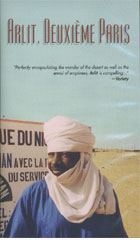
Arlit, Deuxième Paris 2005
Distributed by California Newsreel, Order Dept., PO Box 2284, South Burlington, VT 05407; 877-811-7495 (toll free)
Produced by Idrissou Mora Kpai
Directed by Idrissou Mora Kpai
VHS, color, 78 min.
College - Adult
African Studies, Environmental Studies, Economics
Date Entered: 05/11/2006
Reviewed by Miriam Conteh-Morgan, The Ohio State University Libraries, Columbus, OHWho will be the next to die in Arlit? Will customers ever come back to the empty bar waiting for its new stock of drinks? Will Amadou take his father’s advice and move his family to better economic conditions in the ancestral home country of Benin? How long does everyone have to wait? These are a few of the unresolved questions viewers and the people interviewed have on their minds as Arlit, Deuxième Paris, a documentary about the slow decay of a town in Niger comes to an end.
The director/producer, Idrissou Mora Kpai, allows the residents to tell their story virtually uninterrupted. They recall the boom times of the 1970s and 1980s when Arlit developed around a lucrative uranium mining industry, and when the dusty desert location became a bustling economic center that attracted an international workforce, much air traffic and noisy race cars. The story of the “second Paris,” wistfully recounted by its old and new residents in French, Bariba, Hausa and Tamashek (with English subtitles), evokes the image of an Arlit brimming with a Paris-like vitality until the depressed world price of uranium caused the mines to close or scale back operations and the Tuareg rebellion against central government erupted, both of which brought the town to the present broken state depicted in the film.
Examples of abandonment abound, woven into the beautiful landscape shots and the conversations with townsfolk. Rusting equipment hover in the background, and the man-made peaks of excavated grey earth -- once signs of mining activity -- now dot the blighted wasteland. We listen to complaints about mine-related ailments, and hear both about men who have died and from others waiting to die. They believe they are suffering from cancers, although the company-paid doctor believes they have AIDS and smoke-related illnesses. Viewers also meet two women from neighboring Togo who leave their families behind to seek better opportunities in Arlit, lured by stories of its famous past. In one of the few instances in which Kpai inserts his voice in the film, he tries to probe the thoughts of the women, who stare vacuously into space, waiting for the goods and business to come to the bar. Everyone in Arlit, it seems, sits and waits.
The car repair shop, on the other hand, shows a bit more economic life. It also brings a measure of hope to the stream of migrants who use Arlit as a rest stop before undertaking the dangerous road trip across the Sahara, hoping to reach Spain. Car owners now benefit from a new economic activity – people smuggling. But as one of them confesses, he has no qualms about leaving people stranded in the desert. In that respect, he is hardly different from the multinationals that cut and run from Arlit without a thought for the environmental and health degradation they leave behind.
This well-produced film follows many others that show a plundered Africa left to deal with the consequences of events not of its own making. Here, the extractive nature of mining is symbolic of this plunder. However, while the film’s setting is Africa, the larger story of the unscrupulous multinational corporation is not restricted to the continent. In this regard, the film should be seen as one that addresses unsavory corporate practices everywhere, and this should give it a wider appeal to audiences beyond African Studies.